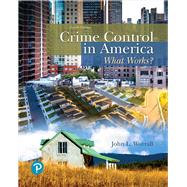Crime Control in America What Works?
, by Worrall, John L.- ISBN: 9780134848181 | 0134848187
- Cover: Paperback
- Copyright: 1/10/2018
For courses in crime prevention, introduction to criminal justice, and criminal justice policy.
Balanced, comprehensive introduction to crime control
Crime Control in America: What Works? provides comprehensive coverage of what works in policing, prosecution, courts, and legislative methods of crime control. It also moves beyond the justice system and examines the effectiveness of crime control at the individual, family, school, and community levels. Finally, it covers environmental criminology and explanations of large-scale crime trends. The 4th edition includes new sections covering the most current and controversial topics in crime control, including the alleged Ferguson effect, immigration enforcement, raising the age of majority, and mass shootings.
John L. Worrall is Professor of Criminology and Director of the M.S. Program in Justice Administration and Leadership (JAL) at the University of Texas at Dallas (UTD). Both his M.A. (criminal justice) and Ph.D. (political science) were received from Washington State University, where he graduated in 1999. Dr. Worrall has published articles and book chapters on a variety of topics ranging from legal issues in policing to crime measurement, having been ranked one of the most prolific sole and lead authors in the discipline. He has also authored a number of other popular books, including Introduction to Criminal Justice (with Larry Siegel) and Criminal Procedure: From First Contact to Appeal. Dr. Worrall is Executive Director of the Academy of Criminal Justice Sciences and continues to serve as editor of the journal Police Quarterly, a position he has held since 2008.
PART 1: INTRODUCTION
Chapter 1: Identifying and Evaluating Crime Control
Crime Control and Prevention
The Crime Problem in America
Approaches, Not Just Policies
On the Importance of Definitions
Evaluating Success: An Impossible Task?
Displacement and Diffusion
The Tentative Nature of Scientific Knowledge
Funding and Political Priorities
Evidence-Based Justice
A Preview of the Book
Summary
Notes
Chapter 2: Crime Control Perspectives
Operational Perspectives
Political Perspectives
Other Perspectives
Goals of Crime Control
Summary
Notes
PART 2: LAW ENFORCEMENT APPROACHES
Chapter 3: Traditional Policing
The Theory of Traditional Policing
Does Hiring More Cops Reduce Crime?
Freeing up Resources
Reactive Policing and Random Patrol
Detective Work and Crime
Private Policing
College Degrees for Cops
Summary
Notes
Chapter 4: Proactive Policing, Directed Patrol, and Recent Advancements
Proactive Arrests
Directed Patrol
Broken Windows and Disorder Reduction
Focused Deterrence
Partnering
Technology and Less-Lethal Weapons
Using Data to Inform Decisions
Summary
Notes
Chapter 5: Community Involvement in Policing
Fixing Strained Police-Community Relations
Community Justice
Community Policing: Some History
Community Policing: What Is It?
Community Policing: Is It Really Happening?
Research on Community Policing Effectiveness
Third-Party Policing
Summary
Notes
Chapter 6: Prosecutors and Crime Control
Prosecutors
The Shift Toward Strategic Prosecution
The Harder Side of Prosecution
The Softer Side of Prosecution
A Plea Bargaining Pandemic?
Summary
Notes
PART 3: LEGISLATION, COURTS, AND CORRECTIONS
Chapter 7: Crime Control Through Legislation
Legislative Bans
Legislative Gun Controls
Public Notification and Related Laws
Other Legislative Approaches
Summary
Notes
Chapter 8: Crime Control in the Courts and Beyond
Courts and Incapacitation
Does It Work?
Diversion
Does It Work?
Shaming
Does It Work?
Restorative Justice
Does It Work?
Antigang Injunctions
Does It Work?
Problem-Solving Courts
Does It Work?
Summary
Notes
Chapter 9: Sentencing
Nonprison Sentences
Types of Prison Sentences
Prison Strategies Without Regard to Sentence Length
Supermax Prisons
Does Sentence Length Matter?
Determinate Sentencing
Sentence Enhancements
Mandatory Sentencing
Capital Punishment
Castration
Summary
Notes
Chapter 10: Probation, Parole, and Intermediate Sanctions
The Organization and Administration of Probation and Parole
Probation and Parole Issues
Intermediate Sanctions
Summary
Notes
Chapter 11: Rehabilitation, Treatment, and Job Training
A Movement Toward the Left
Criminals Are Not Created Equal
Rehabilitation
Treatment
Job Training
More Lessons from Meta-Analysis
Summary
Notes
PART 4: APPROACHES BEYOND THE CRIMINAL JUSTICE SYSTEM
Chapter 12: Individual, Family, and Household Crime Control
Government May Still Be Involved
Individual Crime Control
Household and Family Crime Control
Summary
Notes
Chapter 13: Crime Control in the Community and in Schools
Community Crime Control
School-Based Crime Control
Summary
Notes
Chapter 14: Reducing Criminal Opportunities Through Environmental Manipulation
Some Perspective
A Quick Return to Theory
How Environmental Manipulation Occurs
The Effectiveness of Environmental Manipulation
Summary
Notes
PART 5: CONCLUSION
Chapter 15: Putting It All Together and Explaining Crime Trends
A Quick Review
Three Important Themes
Explaining Crime Trends
Summary
Notes
The New copy of this book will include any supplemental materials advertised. Please check the title of the book to determine if it should include any access cards, study guides, lab manuals, CDs, etc.
The Used, Rental and eBook copies of this book are not guaranteed to include any supplemental materials. Typically, only the book itself is included. This is true even if the title states it includes any access cards, study guides, lab manuals, CDs, etc.
Digital License
You are licensing a digital product for a set duration. Durations are set forth in the product description, with "Lifetime" typically meaning five (5) years of online access and permanent download to a supported device. All licenses are non-transferable.
More details can be found here.






